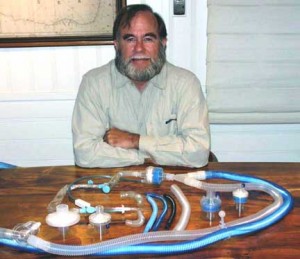
Burrell (Bo) Clawson is a mechanical designer/inventor in Newport Beach, CA [email protected]
As an inventor/medical product designer, I was on the drawing board for 25 years … until PowerDraw 2.0 from Engineered Software arrived in the late 80s. I quickly went from 2-3 draftsmen/designers executing paper drawings back to just myself doing all part and tooling drawings, and I have never looked back (yes, I tried five different CAD applications back then and PowerDraw won hands down for productivity). My work has concentrated on breathing equipment for SCUBA and Fireman’s self-contained breathing equipment to doing respiratory ventilator pneumatics and regulator design to disposable breathing ventilator circuits and humidifier components over the last 30 years.
The plastic parts I design require drawings of parts, assembly fixtures, ultrasonic bonding horns, prototype and production injection molds, extrusion dies & corrugated molds for extruded corrugated tubing.
When I concentrate on a new concept or innovative design, it is rarely instantly evident what the final design will be once the range of factors and possibilities are considered. I find it common to look at 5-15 ways of accomplishing a design for a new product before picking the “best” design. PowerCADD has proved itself eminently efficient at quickly allowing me to investigate all the possibilities I see while “drawing at the speed of thought.” If I were to try to do this creative work in 3D solids it would take much longer and result in often drastic changes or total remaking of a solids model from scratch to “look” at another new design. 3D solids doesn’t lead itself to quick creative fluidity in seeing the variations I want to consider. 3D Solids does work well for doing CNC machined parts, however.
PowerCADD lets me do drawings fast wherever I am located. WildTools has expanded the ease of use of more complicated drafting operations to the point where I don’t think of PowerCADD without WildTools. PowerCADD’s user-assignable command keys are a big part in achieving drawing speed. It used to be that isometric assembly drawings were a nightmare in school days with hours and hours of work for simple assemblies. I don’ t do isometric views often, but can do them rather quickly with WildTools when needed.
Getting drawings and details to other people is a must. “Copy” from PowerCADD and “Paste” into most any Mac application from word processors to databases is trivially easy, or using Mac screen shots and a selection rectangle and also to create pdf files is as easy, and it is a natural for cross platform use for read-only files. I use colored lines and fills a lot, because they lend clarity to complicated assemblies.
I routinely do drawings or modifications in the shop, at vendors, trade shows or in hospitals when measuring up equipment or machining and almost never do pencil sketches any more. Hospital clinicians are surprised seeing me draw CAD drawings “in the ward”. I also take my Mac laptop out to the lathe and mill when I cut simple parts rather than printing paper (so far so good … no disasters yet — keep the screen closed on the keyboard when the chips fly).
PowerCADD does for design is what MS Office does for the business office. Simplicity and speed often win out over needless “professional” complexity and PowerCADD does it in 2D CAD for me.
It is easy in life to ask for too much and the same occurs in CAD. 3D has specific advantages for certain operations, but takes longer to construct objects than doing traditional 2D, and isn’t as useful or quick for drawing a series of “Trial Balloons”. 3D typically is going to set a user back $3-5,000 minimum and have a vastly longer learning curve, so ‘buying 3D’ is only the start of a long process. PowerCADD on the other hand, is a product a user familiar with Macintosh can use and start drawing details within hours. PowerCADD is very close in icons, palettes, drawing surface and in methods of tool use to such programs as Microsoft Office, so its methods of drawing are already familiar to tens of millions of users. In the end game, it is quick and productive.
The drawings I’ve submitted for the Drawing Room generally have had notes and dimensions removed for clarity. They were all originally used for design or construction, however, and are not merely “illustrations”.
Bo Clawson









